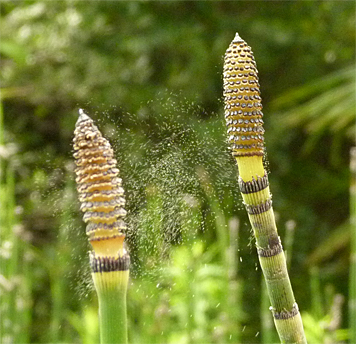
If you’ve been to the Dinosaur Trail and walked past the Troodons, you’ve seen horsetail. There are more than twenty species of horsetail (Equisetum) some of which grow straight and tall with little branching, some branch out extensively from the hollow central stem, some grow in water, and some grow in dryer habitats, but they all have one thing in common, the do not have flowers or produce seeds.
Although once established horsetails spread ?from rhizomes under the soil, Equisetums reproduce from spores, similar to the way ferns or mushrooms reproduce. The fact that these plants do not produce flowers is one of the reasons that they’re planted on the Dinosaur Trail, they’re an ancient plant. Flowering plants are a relatively new addition to the world’s flora.
The spores are released from a Strobilus (stro bi’ lus), a cone-like structure at the tip of the plant’s stem. The spores are spread either by the wind, the bump of some passing animal, or the flick of a naturalist’s finger.

Horsetail is variously know as Bottlebrush, Corncob Plant, Dutch Rushes, Scouring Rush, Paddock-pipes, and many other names. You may not be surprised from those names that horsetail can be used to scrub pots and polish metal. This use as a cleaning tool is due to the presence of silica within the plant’s stem.
Equisetum also has many medicinal uses for everything from healing ulcers to kidney problems. It seems though, from what I’ve read, that it’s most often prescribed for kidney, bladder, and urinary tract conditions.
Also contained within the plant is potassium, aluminum, manganese, saponins, phytosterols, phenolic acids, cafeic acids, alkaloids, and tannins.
Horsetail is a very useful plant.
Where does the name horsetail come from? The common name is derived from the scientific name Equisetum which, broken down is equus (horse) and seta (bristle). Where does the scientific name come from? The scientific name comes from the plant’s resemblance to a horse’s tail. Although our variety of horsetail (on the Dino Trail) doesn’t look at all like the tail of a horse, the large, branching variety does bear at least some resemblance to the bushy end of a horse.

How did I get the picture of the spores flying off of the strobilus? Well, if you remember from above, “The spores are spread either by the wind, the bump of some passing animal, or the flick of a naturalist’s finger.”

Kristin must have flicked a dozen of these stalks before I was able to get a decent shot of the spores flying through the air.
Thanks Kristin!
The shot of the airborne spores is phenomenal (literally)! Equisetum spp. are some of my favorite plants; it is alwyas such a treat to see them.
cheers,
Wilma
Thank you.
The horsetail is certainly one of my favorites here at the Museum, its a great place to spot, and to point out to visitors, Green Treefrogs at this time of year. Whenever thunderstorms roll through, or even threaten to roll over us, the frogs climb up the horsetail stalks, ready to mate. Very exciting!
Have a good one,